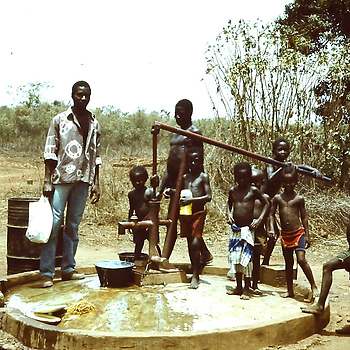Buba pump
1980 Buba pump
• Year of start. Ca 1980
• Started, funded by Government Netherlands
• Pump type Low head hand pump
• Pump range, depth. 30 m
• Cost of complete pump ca 1000 US$ (for 30 m deep )
• Produced in Guinee Bissau, materials from Netherlands
• Applied in Guinee Bissau
• Total installed Ca 500
• % of pumps functioning in 2019 < 20%
Lessons learned.
• Weak parts in the pump were bearings and the pump pipes and pump rods. Because of the low PH of the ground water these parts corroded fast.
• Cost of repairs of the pump were very high
• Maintenance and repairs of this pump required skilled technicians and there were not enough local and skilled technicians.
• Communities expected water (pump repairs) to be free and were probably not informed, prepared enough that they had to pay for maintenance and repairs
• Many pumps that broke down were not being repaired.
• The Buba pump was not a VLOM (Village Level Operation and Maintenance) pump.
• If communities are not able or willing to pay for pump repairs, the project will fail
• Another condition to keep pumps ruiing are avilablilty of spares and skilled technicians who earn with repairing pumps
History
The development of the Buba hand pumps started in 1980 in The Netherlands to be applied in the Buba project in southern part of Guinee Bissau. The aim of this project was to improve rural water supply. The duration was 4 years.
All materials were imported from the Netherlands so there were high cost for transport and import taxes. Weak parts in the pump were bearings and the steel pump pipes and pump rods. Since the groundwater had a low PH, pump pipes and rods corroded relatively fast. After the project there were intentions to use corrosion free pumps WAVIN pumps but this was not sustained. Later on many Buba pumps were replaced by Indian Mark 2 pumps.
